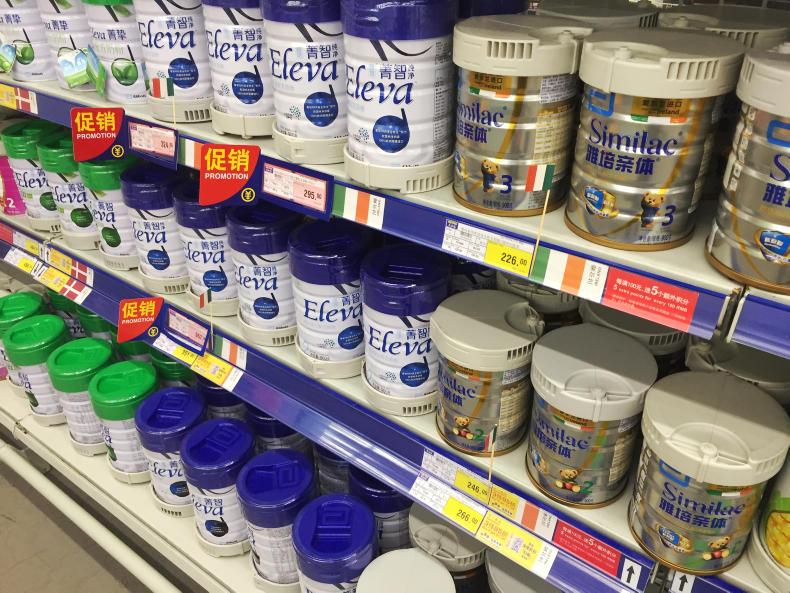I recently travelled to the east coast of China as part of my Nuffield scholarship to gain a better understanding of how the agri food industry can capitalise on some of the market opportunities that exist in the world’s most populous country.
China’s 1.4bn inhabitants are continuing to enjoy one of the most rapid improvements in living standards in generations.
Millions of people have been lifted out of poverty over the past 20 years.
As the world’s second largest economy has expanded, so too has the number of middle-class income earners, with an estimated 500m people now in this category.

Tiffany FU and Cathy Xu, InvestNI Trade and investment staff, with Barry O’Boyle and Stephy Lin, Asia Pacific manager Lakeland Daires.
This figure is set to accelerate to 800m by the mid 2020s, many of whom will have disposable income to spend on premium foods.
Urbanisation continues to be the trend, with almost 60% of the population now living in cities across China.
The rural population is continuing to migrate towards these cities, seeking higher living standards and opportunities for better employment.
Many are former small subsistence farmers who have left their holdings behind.
Infrastructure
One of the underpinning successes of the Chinese economy has been the strategic efforts by the communist government to modernise public transport infrastructure.
China has become a world leader on big infrastructure, from a 300kph Bullet train network, to new five-lane motorways and large-scale airports – every project seems achievable here, no matter its scale or cost.
The food industry has benefited massively from this improved infrastructure, allowing perishable products to be distributed seamlessly to the end customer in record time.
Opportunities
The infant formula melamine scandal of 2008 was the worst food safety scandal in Chinese history.
It shattered confidence in domestically produced dairy products, confidence which is still lacking 10 years on.
Since 2008, the dairy market had no choice but to open up to increasing dairy imports.
The UK dairy industry accounted for a small amount of EU exports, but it was still worth £96m in 2017
While the market is dominated by New Zealand, the EU holds a small proportion of total dairy imports into China, at an estimated 10%.
The UK dairy industry accounted for a small amount of EU exports, but it was still worth £96m in 2017.

Irish infant formula products on sale in Shanghai, China. \ Thomas Hubert
In 2018, the UK and China agreed a deal that will allow UK dairy products made from milk sourced in third countries (such as the Republic of Ireland) to access the Chinese market.
This is positive news for the NI dairy industry, with China likely to become a key market outlet once the UK is outside the EU.
Invest NI is also preparing to support the NI agri food industry to access export opportunities, and has significantly increased staff numbers in both Beijing and Shanghai.
Consumers
Like everything else in China, consumer trends change quickly.
This has made it difficult for food companies to keep pace with new product development.
Convenience foods and snacks are one of the fastest-growing market segments, as seen with the rise in the number of coffee shops and fast food outlets across many of the big cities.
Chinese consumers are also spoilt for choice, as they now have access to a large range of imported products
Despite lactose intolerance being prevalent in the population, most people seem to continue to consume dairy products regardless.
Yoghurt, cheese and cream products are all seeing huge growth at the moment.
But Chinese consumers are also spoilt for choice, as they now have access to a large range of imported products.
Most buy on visual appearance, with strong brands and packaging important when making food choices.
Cashless
One area that China has leapfrogged western cultures is the rapid rise of a cashless society.
Most purchases take place using smartphone apps by simply scanning a QR code on a product.
The money is deducted from your bank account through a payment provider, such as Alipay.
China has now the largest online grocery market in the world, which has grown at 30% in the last 12 months
This has led to drastic changes in the traditional sales channels for groceries.
China has now the largest online grocery market in the world, which has grown at 30% in the last 12 months.
This has given imported food brands an opportunity to sign partnership agreements to get their produce to a wider audience.
Mainstream websites such as JD.com and Alibaba.com are the most popular. Products are then delivered quickly to the end customer.
Read more
Gaining a global view of agriculture
Dairy markets: Chinese dairy imports set for double-digit growth in 2019
I recently travelled to the east coast of China as part of my Nuffield scholarship to gain a better understanding of how the agri food industry can capitalise on some of the market opportunities that exist in the world’s most populous country.
China’s 1.4bn inhabitants are continuing to enjoy one of the most rapid improvements in living standards in generations.
Millions of people have been lifted out of poverty over the past 20 years.
As the world’s second largest economy has expanded, so too has the number of middle-class income earners, with an estimated 500m people now in this category.

Tiffany FU and Cathy Xu, InvestNI Trade and investment staff, with Barry O’Boyle and Stephy Lin, Asia Pacific manager Lakeland Daires.
This figure is set to accelerate to 800m by the mid 2020s, many of whom will have disposable income to spend on premium foods.
Urbanisation continues to be the trend, with almost 60% of the population now living in cities across China.
The rural population is continuing to migrate towards these cities, seeking higher living standards and opportunities for better employment.
Many are former small subsistence farmers who have left their holdings behind.
Infrastructure
One of the underpinning successes of the Chinese economy has been the strategic efforts by the communist government to modernise public transport infrastructure.
China has become a world leader on big infrastructure, from a 300kph Bullet train network, to new five-lane motorways and large-scale airports – every project seems achievable here, no matter its scale or cost.
The food industry has benefited massively from this improved infrastructure, allowing perishable products to be distributed seamlessly to the end customer in record time.
Opportunities
The infant formula melamine scandal of 2008 was the worst food safety scandal in Chinese history.
It shattered confidence in domestically produced dairy products, confidence which is still lacking 10 years on.
Since 2008, the dairy market had no choice but to open up to increasing dairy imports.
The UK dairy industry accounted for a small amount of EU exports, but it was still worth £96m in 2017
While the market is dominated by New Zealand, the EU holds a small proportion of total dairy imports into China, at an estimated 10%.
The UK dairy industry accounted for a small amount of EU exports, but it was still worth £96m in 2017.

Irish infant formula products on sale in Shanghai, China. \ Thomas Hubert
In 2018, the UK and China agreed a deal that will allow UK dairy products made from milk sourced in third countries (such as the Republic of Ireland) to access the Chinese market.
This is positive news for the NI dairy industry, with China likely to become a key market outlet once the UK is outside the EU.
Invest NI is also preparing to support the NI agri food industry to access export opportunities, and has significantly increased staff numbers in both Beijing and Shanghai.
Consumers
Like everything else in China, consumer trends change quickly.
This has made it difficult for food companies to keep pace with new product development.
Convenience foods and snacks are one of the fastest-growing market segments, as seen with the rise in the number of coffee shops and fast food outlets across many of the big cities.
Chinese consumers are also spoilt for choice, as they now have access to a large range of imported products
Despite lactose intolerance being prevalent in the population, most people seem to continue to consume dairy products regardless.
Yoghurt, cheese and cream products are all seeing huge growth at the moment.
But Chinese consumers are also spoilt for choice, as they now have access to a large range of imported products.
Most buy on visual appearance, with strong brands and packaging important when making food choices.
Cashless
One area that China has leapfrogged western cultures is the rapid rise of a cashless society.
Most purchases take place using smartphone apps by simply scanning a QR code on a product.
The money is deducted from your bank account through a payment provider, such as Alipay.
China has now the largest online grocery market in the world, which has grown at 30% in the last 12 months
This has led to drastic changes in the traditional sales channels for groceries.
China has now the largest online grocery market in the world, which has grown at 30% in the last 12 months.
This has given imported food brands an opportunity to sign partnership agreements to get their produce to a wider audience.
Mainstream websites such as JD.com and Alibaba.com are the most popular. Products are then delivered quickly to the end customer.
Read more
Gaining a global view of agriculture
Dairy markets: Chinese dairy imports set for double-digit growth in 2019








 This is a subscriber-only article
This is a subscriber-only article










SHARING OPTIONS: